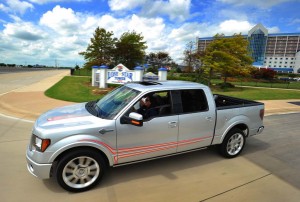Fuel prices may be nudging back up again but Americans are once again racing to plunk their money down on pickups, vans and SUVs again, light trucks collectively accounting for 54.8% of the U.S. market last month – with the Ford F-Series wrapping up 2011 as the best-selling vehicle in the country for the 30th year in a row.
While Americans might have been racing to buy small cars and hybrids early in the year, demand clearly slipped as 2011 came to a close, Honda selling just 690 of its Insight hybrids last month, or less than one per dealer.
Pickups, it turned out, dominated the sales charts, the Chevrolet Silverado slipping into the number two sales slot behind Ford’s F-150, and a range of other trucks – from the newly redesigned Ford Explorer to Chrysler’s relaunched Jeep Grand Cherokee – reporting December gains well into the double-digits.
While that trend might not please environmentalists and regulators pressing to drive up the nation’s Corporate Average Fuel Economy, there’s still a reason to be pleased by the news, the rise in demand for full-size pickups, in particular.
“The correlation between full-size pickup sales with housing starts is almost one-to-one,” suggests Doug Scott, Ford’s Truck Group Marketing Manager.
There’ve been some modest but positive signs in the housing market recently. Whether the surge in full-size pickup sales signals still more good news to come remains to be seen.
An alternative explanation is that the burst of truck activity, especially in the pickup segment, last month was driven by factors such as pent-up demand and business tax credits. There’s traditionally a bit of a bump in December as businesses look for every deduction possible.
Meanwhile, there’s clearly been pent-up demand at work throughout the automotive market, according to CNW Marketing chief Art Spinella. And that appears to be particularly so when it comes to work trucks like large pickups.
“We heard that from our dealers,” echoes Ford’s Scott. Owners have been struggling to make their old vehicles last as long as possible but at some point, he said, that’s simply too much trouble. If you’re losing work because your truck doesn’t run it’s time to trade in.
Another factor also working for manufacturers, ironically enough, is fuel economy. In some cases, pickup buyers might be able to boost mileage by as much as 30% trading in a 10-year-old truck on a new model.
That’s clearly worked for Ford, which has made much of the fact that it launched an all-new range of powertrains for the F-Series in 2011 – notably including a pair of V-6s. And the turbocharged EcoBoost version effectively matches the towing and cargo capacity of a conventional V-8.
The EcoBoost engine accounted for 40% of F-Series sales in December, with both V-6s capturing 52% — the eighth month in a row that the majority of Ford’s full-size pickups were ordered with six-cylinder engines, something Scott admits he wouldn’t have thought possible a year or two ago.
For December, Ford saw F-Series sales surge to 68,278, a 24% year-over-year increase. For the full year, sales rose 11%, to 584,917. Nonetheless, that’s still down sharply from 2004, when the maker moved 939,511 of the big rigs.
As a share of the overall market, full-sized pickups gained a little ground – but grew only to 11.5% of total U.S. new vehicle sales. That’s down from a peak of 14.7%, according to industry data. At that peak, the full-size segment generated 2.5 million sales annually, the number rising to barely 1.5 million in 2011.
The economic downturn is one key reason, but there’s also a more fundamental and likely permanent shift, acknowledges Scott. It’s no longer hip to own a pickup if you don’t use one for work.
“Most of those suburban cowboys,” he adds, “have long since left the market.”
Looking ahead, the Ford truck marketing chief anticipates the full-size truck share will settle in between 11.5 and 12.0%. But as the overall automotive market recovers that should still give the F-Series – and its competitors – room for growth.

